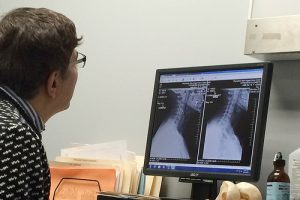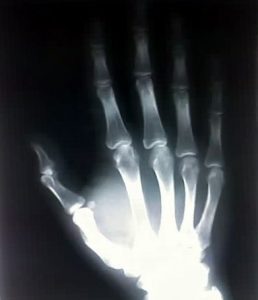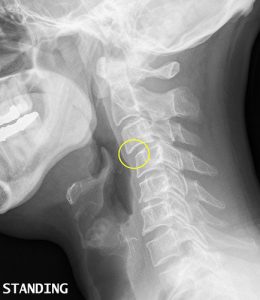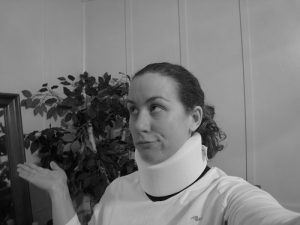Carpal Tunnel Syndrome And What Your Options Are
Houston Chiropractor Comments: Carpal Tunnel Syndrome or CTS, has been reported to be the most expensive of all work-related injuries, costing the average CTS patient about $30,000 in medical bills and lost work time over his or her lifetime. CTS is primarily found in adults, is 3x more frequently found in woman, and usually affects the dominant hand first. The pain can be quite severe and disabling. Certain occupations tend to cause CTS more than others, such as manual labor jobs (assembly-line / manufacturing, sewing, finishing, cleaning, meatpacking, food processing and packing occupations). Other jobs like computer work, playing a musical instrument and waitressing can also cause CTS. Certain medical conditions such as diabetes, obesity, pregnancy, the use of birth control pills, inflammatory arthritis and hypothyroidism can predispose patients to Carpal Tunnel Syndrome. CTS is caused by a pinch to the median nerve that runs down the arm from the neck, through shoulder, elbow and wrist. The pinch can occur in one or more of these locations making it important to obtain a complete evaluation including the neck and upper arm – not just the wrist. There are a total of 9 tendons, ligaments, and blood vessels jammed into the tight confines of the carpal tunnel formed by 8 small carpal bones and the transverse carpal ligament that serves as the “roof” of the tunnel. Symptoms include burning, tingling, aching, and/or numbness primarily into the 2nd to 4th fingers and at times, the thumb. Some sufferers develop weakness in their grip making it hard to open jars, stubborn door knobs, holding onto a newspaper or steering wheel. Waking up multiple times at night is also a common complaint caused by sleeping with the wrist bent, which increases the pressure inside the tunnel, thus pinching the nerve more firmly.

A CTS diagnosis is made by reproducing the symptoms by further compressing the median nerve inside the tunnel. This is accomplished by applying pressure over the tunnel, by bending the patient’s wrists 90 degrees backwards (dorsiflexion) and forwards (palmar flexion), compression over the proximal forearm, at the thoracic outlet (under the collar bone) and / or at the neck. Special tests like an EMG/NCV (electromyogram and nerve conduction velocity) can determine the degree of nerve damage and verify the diagnosis. At times, x-ray or MRI are helpful if arthritis or a bone spur is suspect, or to measure the size of the carpal tunnel. Laboratory blood tests to determine secondary causes, described earlier, can also be of benefit.
Carpal tunnel syndrome treatment and wrist pain treatment consists of 1. Rest 2. Modifying the activity or workstation suspected of causing CTS 3. Using a splint- especially at night and when driving; and 4. Managing any underlying disease condition. Managing inflammation is also important, which can be accomplished by the use of ice of. Ice massage is very effective. This consists of freezing water in paper cups, tearing off the top half of the cup, and rubbing the ice against the skin for approximately 5 minutes. The sequence of sensations includes cold, burning, aching, and numbness. Make sure you quit when numbness is reached, as frost bite is a risk if performed for too long. Anti-inflammatory medications like ibuprofen, naproxen, or herbal remedies such as ginger, turmeric, boswellia, and/or vitamins like bromelain & papain, vitamin B6, fish oil (omega 3 fatty acids), Vitamin D and calcium/magnesium are all potentially helpful. Manual manipulations to the joints of the neck, shoulder, elbow, wrist and hand and soft tissue manipulation to the muscles and tendons of the forearm and hand can also be used. Other non-surgical treatments include exercises and physical therapy modalities such as low level laser therapy, electrical stimulation, ultrasound, and Rock Tape.
We realize you have a choice in where you choose for your healthcare services. If you, a friend or family member requires care for Carpal Tunnel Syndrome, chiropractic care is a logical first choice and we would be honored to offer our services to you.
Dr. Ward Beecher practices at Beecher Chiropractic Clinic at 1001 Pineloch, Ste 700 Houston, TX 77062. You can schedule an appointment at BeecherChiropractic.com or by calling (281) 286-1300. If you have any questions regarding this blog, please comment below!
Neck Pain Causes and Chiropractic Treatment
Houston Chiropractor Comments: What are some common neck pain causes? Neck pain is a very common complaint that chiropractic has been found to be very effective in treating.
Common Neck Pain Causes
There are many neck pain causes including posture related (such as a forward head carriage) and repetitive strain (such as long static holding of awkward positions). These two causes are very similar as the head weighs approximately 15 pounds and when held in a forward translated position for a lengthy time frame, the muscles fatigue and begin to ache. This is similar to holding a baby in your arms for a long time frame. We soon find ourselves moving the baby to the other arm or against our chest due to the gradual increasing strain placed our upper quarter muscles. Hence, we must similarly change the forward head position when we are working at the computer, listening or talking (especially if the person is not directly in front of you), reading a book, cooking, and so forth.
Another cause of neck pain is trauma. This could be neck pain from whiplash caused by a car accident, a slip-and-fall injury, sports injury, and more. These injuries are highly variable as no two injuries or accidents are the same and, there are a wide variety of neck sizes in both length and girth and hence, the same trauma may hardly result in an injury in one person and greatly injure a smaller, more petite person. Your doctor of chiropractic will ask you about the “mechanism of injury” as that can give us clues about which tissues are injured. For example, in a motor vehicle collision, if the impact occurs from the side verses the rear end of the car, the tissues in the neck are stretched differently and the management/treatment may vary accordingly.
Other neck pain causes include a “slipped” or herniated disk. A herniated disk is like a jelly donut where the jelly leaks out and presses against a nerve that travels down the arm. Symptoms often include pain, numb, tingling, burning, weakness, or combinations of these sensations down the course of the nerve. When this occurs, the person is usually quite specific about where the pain is traveling such as, “…it goes down my arm to my ring and little finger.” Dr. Beecher can offer chiropractic herniated disc neck treatment as well.

Another cause can be related to natural aging process involving the “wearing out” process of the disk, joints, and muscle/ligament attachments. The term, “osteoarthritis” is commonly associated with these findings and is often blamed for neck pain, but this is controversial. First, osteoarthritis (OA) takes years to develop and many people have a significant amount of OA but literally no pain or symptoms while others with only a little x-ray evidence of OA present with an abundance of pain.
Your Neck Pain Causes and Chiropractic Treatment
So, how do chiropractors manage all of these causes of neck pain? A thorough history, examination, and locating the positions of pain production verses pain relief are “key” to the successful management of patients with neck pain. For one patient, traction/stretching types of manual adjustment techniques work best while for the next, this may not be tolerated at all, which is why we “pre-position” the patient prior to administering an adjustment.
Other chiropractic treatment for neck pain considerations may include exercise instruction, physical therapy modalities (electric stim, ultrasound, etc.), the use of ice, re-adjustment of a computer monitor or work set up and nutritional considerations. If you, a family member or a friend require care, we sincerely appreciate the trust and confidence shown by choosing our service.
Dr. Ward Beecher practices at Beecher Chiropractic Clinic at 1001 Pineloch, Ste 700 Houston, TX 77062. You can schedule an appointment at BeecherChiropractic.com or by calling (281) 286-1300. If you have any questions regarding this blog, please comment below!
Natural Muscle Spasm Treatment
Clear Lake City Chiropractor Comments: A common question that I get consistently from patients, old or young, male or female, athletic or a couch potato is what they can do for muscle spasm treatment. For the sake of this article I will call a muscle spasm a forceful, intermittent & involuntary contraction of a muscle. A cramp is a sustained muscle spasm.
A muscle spasm is usually due to a muscle sprain, exercise, a joint irritation, dehydration, metabolic disorders or just overall fatigue. A cramp is due to the same things plus inadequate blood supply, mineral depletion or nerve compression.
Muscle Spasm Treatment
When you feel a muscle spasm or cramp, stop what you are doing. Try and massage and stretch the affected muscle out. If the problem is due to an acute (new) injury or sprain then put ice on it for 20 minutes and then off for 40 minutes. You can repeat this multiple times, but remember that after 20 minutes you will have gotten the maximum therapeutic benefit from the ice. The ice will help reduce the inflammation and irritation of the muscle. If this is a chronic (older) issue then moist heat will be beneficial. Use the heat for the same amount of time as the ice. Make sure that you are properly hydrated by drinking plenty of water. Coffee, tea and sodas are diuretics and tend to lead towards dehydration as does alcohol. If the spasm is due to exercise or an injury then make sure to give the muscles time to heal by minimizing activity. If things get worse, please consult with a physician or chiropractor about sports related rehabilitation or chiropractic rehabilitation.
Certain mineral deficiencies, such as calcium, potassium, magnesium and sodium can also lead to muscle cramps. The U.S. Department of Agriculture has recommendations for every vitamin and mineral in your diet. For potassium, the USDA suggests eating 4,700 milligrams per day. Potassium-rich foods include sweet potatoes, tomatoes, soy, yogurt and tuna. Your calcium intake should equal 1,000 milligrams per day. Good sources of calcium include sardines, soy, leafy green vegetables and dairy. A healthy diet also includes 420 milligrams of magnesium per day. Foods high in magnesium include nuts, squash, bran and lima beans. Other vitamins that can have an effect on your muscle irritability are vitamin D, E, B-1 & B-7. These all can help naturally treat muscle spasms.
Your Clear Lake Houston chiropractic Dr. Ward Beecher practices at Beecher Chiropractic Clinic at 1001 Pineloch, Ste 700 Houston, TX 77062. You can schedule an appointment at BeecherChiropractic.com or by calling (281) 286-1300. If you have any questions regarding this blog, please comment below!
Three Chiropractic Terms You Should Know
Three Chiropractic Terms You Should Know
Chiropractor In Clear Lake, TX Comments: Like all professions, chiropractic medicine has its own terminology. Every week I will have a new patient ask me what at least one of these three words mean. The three most common chiropractic terms that I am asked to define are chiropractic, subluxation and adjustment.
First Of The Three Chiropractic Terms Is Chiropractic.
This one always surprises me. Almost all of my patients are referred in by friends and family members that have already received excellent results over the past 26 years yet they don’t tell them what chiropractic is or what we do. Just to come to my office and we will get them better as quickly as possible. By definition chiropractic means done by hands. Chiropractic is a system of complementary medicine based on the diagnosis and manipulative treatment of misalignments of the joints, especially those of the spinal column, which are held to cause other disorders by affecting the nerves, muscles, and organs. In short, we use our hands (and sometimes instruments) to move joints (either in the spine or in the extremities) to help fix problems. At our office we also use physical modalities and exercises to help make sure that the problem does not return. Chiropractic is surprisingly one of the chiropractic terms you should know!
What Does Subluxation Mean?

What is the definition of subluxation? For most of our patients, this is one of the causes of their complaints. A subluxation is a partial dislocation or a bone that is slightly out of alignment with the bone next to it. This misalignment causes the joints to not line up correctly and the muscles to pull unevenly which causes pain, numbness, weakness etc.
Adjustment Is The Final Chiropractic Term
This is what is done to correct the subluxation. An adjustment uses a light, quick impulse of the hands (or an instrument) to move the joint back into the correct position. It is more specific than a general mobilization of a joint which a medical doctor, trainer or physical therapist will perform.
So in short if you are having neck, back or joint pain or discomfort the cause might be a subluxation that would be treated by an adjustment by a chiropractor. That is chiropractic.
Dr. Ward Beecher is your chiropractor in Clear Lake, TX and practices at Beecher Chiropractic Clinic at 1001 Pineloch, Ste 700 Houston, TX 77062. You can schedule an appointment at BeecherChiropractic.com or by calling (281) 286-1300. If you have any questions regarding this blog or any other chiropractic terms, please comment below, call, or email!
The Body & Mind and Connection of Whiplash?
Clear Lake Chiropractor
Clear Lake Chiropractor Comments: The term “whiplash” refers to an injury to the neck muscles, the muscle attachments (tendons), ligaments, and sometimes the disks that lie between the vertebral bodies of the spine. In a rear-end collision, the cause of whiplash occurs from a sudden, rapid acceleration of the body and neck as the car is pushed forwards. In these first moments following impact, the head remains in the same place while the body is propelled forward. This is followed by a “crack-the-whip” movement of the head and neck when the muscles in the front of the neck stretch like rubber bands and suddenly spring the head forwards, all occurring in less than 1 second. The force on the head and neck is further intensified if the seat back is too springy, or angled back too far. Also, if the headrest is too low, the head may ride over the top and more injury can result.
Treatment of whiplash

The treatment of whiplash varies from “watchful waiting” to a multidisciplinary team approach that includes neurology, physical therapy, chiropractic, psychology, and possibly surgery (rare). In an article published in the American Journal of Physical Medicine and Rehabilitation, the relationship between clinical, psychological and functional health status factors was investigated in a group of patients with chronic whiplash-associated disorder (WAD). A total of 86 patients with chronic WAD participated in the study and outcomes were tracked using questionnaires that measure pain, disability and psychological issues including depression, anxiety and catastrophizing. Physical examination factors included measuring the cervical range of motion. An analysis of the degree of neck disability and the relative contribution of physical vs. psychological factors revealed catastrophizing and depression played greater roles than did cervical range of motion. This suggests psychological factors play an important role in the outcome of whiplash.
Finding a Chirpractor
The importance of this is that more than just the physical factors like range of motion should be focused on when treating chronic whiplash patients. Answering the patient’s questions, explaining the mechanism of injury and how that relates to their specific condition, and addressing depression, anxiety, coping, and other psychological issues is very important. Discussing treatment goals with patients is also very important. For example, making light of the injury by stating something like, “…you’ll be fine after the treatments,” may harm the patient as anything short of “fine” may be interpreted as failed treatment by the patient. It is also important not to paint too dismal of a picture as that can have negative psychological effects as well, as this may suggest that they will never improve. Explaining the difference between “hurt” and “harm” is of great value to the chronic whiplash patient as they are often told, “if it hurts, don’t do it.” This sends an unfortunate message to the patient that any activity where an increase in pain occurs is “bad” when in fact, that activity may help the patient get better in the long run. This can make or break an acceptable outcome as many may feel like they shouldn’t do anything and this can lead to unemployment, boredom, and the many psychological issues previously described. The best advice is to remain active and try to ignore discomfort by staying within “reasonable activity boundaries.” Reasonable activity tolerance is learned as time passes and trying different activities for different lengths of time. This type of coaching should be at the center of chronic whiplash management rather than over focusing on physical factors such as range of motion. If you would like to know more about whiplash or would like treatment, please contact your Houston chiropractor, Beecher Chiropractic!
What Do Insurance Companies Say About Chiropractic?
Houston Chiropractic Comments: If chiropractic care helps patients get better faster and costs the patient and/or insurance company less, shouldn’t EVERY low back pain patient FIRST see a chiropractor before any other type of doctor? That is in fact, what should be done, based on the literature.

A few years ago a report was delivered on the impact on population, health and total health care spending. It was found the addition of chiropractic care for the treatment of neck and low back pain “…will likely increase value-for-dollar in US employer-sponsored health benefit plans.” Authored by an MD and an MD/PhD, and commissioned by the Foundation for Chiropractic Progress, the findings are clear; chiropractic care achieves higher satisfaction and superior outcomes for both neck and low back pain in a manner more cost effective than other commonly utilized approaches.
The study reviews the fact that low back and neck pain are extremely common conditions consuming large amounts of health care dollars. In 2002, 26% of surveyed US adults reported having back pain in the prior 3 months, 14% had neck pain and the lifetime prevalence of back pain was estimated at 85%. LBP accounts for 2% of all physician office visits where only routine examinations, hypertension, and diabetes result in more. Annual national spending is estimated at $85 billion in the US with an inflation-adjusted increase of 65% compared to 1997. The numbers have continued to rise thru 2016 as the population ages. Treatment options are diverse ranging from rest to surgery, including many various types of medications. Chiropractic care, including spinal manipulation and mobilization, is reportedly also widely utilized with almost half of all patients with persisting back pain seeking chiropractic treatment.
In review of the scientific literature, it is noted that 1) chiropractic care is at least as effective as other widely used therapies for low back pain; 2) Chiropractic care, when combined with other modalities such as exercise, appears to be more effective than other treatments for patients with neck pain. Other studies reviewed reported patients who had chiropractic coverage included in their insurance benefits found lower costs, reduced imaging studies, less hospitalizations, and surgical procedures compared to those with no chiropractic coverage. They then utilized a method to compare medical physician care, chiropractic physician care, physiotherapy led exercise and, manipulation plus physiotherapy-led exercise for low back pain care. They found adding chiropractic physician care is associated with better outcomes.
When combined with exercise, chiropractic physician care was also found to be very cost-effective when compared to exercise alone. When comparing the cost effectiveness of chiropractic care with or without exercise even at 5 times the cost of the care they utilized in their analysis, it was still found to be “substantially more cost-effective” compared to the other approaches. It will be interesting given these findings if insurance companies and future treatment guidelines start to MANDATE the use of chiropractic FIRST – it would be in everyone’s best interest!
If you, a family member or a friend require care, we sincerely appreciate the trust and confidence shown by choosing our services and look forward in serving you and your family presently and, in the future.
Dr. Ward Beecher practices at Beecher Chiropractic Clinic at 1001 Pineloch, Ste 700 Houston, TX 77062. You can schedule an appointment at BeecherChiropractic.com or by calling (281) 286-1300. If you have any questions regarding this blog, please comment below!
What is Chiropractic Treatment of Whiplash?
To download a copy of this week’s newsletter, please click here.
Clear Lake City Chiropractor Comments: Whiplash is basically an injury to the muscles, the muscle attachments (tendons), ligaments, and sometimes the nerves that exit the cervical spine. The degree of injury is highly variable and depends on many factors, some of which include gender/body size (slender woman are especially at risk), awareness of the impending collision, head position at time of impact, the angle of the seat back (bent back is worse that upright), the position of the headrest (too low is common), the amount of vehicle damage (less damage can be worse due to energy transferred to the contents/occupants), the speed of the collision, and many others.

Therefore, when discussing the treatment approaches used by chiropractors, it is not appropriate to generalize since each case is so unique. With that said, when a whiplash patient visits a chiropractor, the first step is obtaining as much information as possible. A thorough history and examination are important in determining the treatment plan and help to determine severity of the injury. Chiropractors often offer different types of treatment that may include: manipulation, physical therapy modalities such as muscle stimulation, relaxation, ultrasound, low level laser therapy, cervical traction, and others. Spinal manipulation (often referred to as an adjustment) addresses joint dysfunction and can be performed with one of several approaches. The first and quite common approach uses a high velocity, low amplitude (quick) approach where joint cavitation (the “crack”) often occurs. Another approach is a low velocity, low amplitude technique where mobilization is used, which is more of a stretch to the end-range of intersegmental (between the vertebrae) motion and rarely, is there joint noise/cavitation.
Muscle relaxation or stimulation is performed for muscle dysfunction, which may include relaxation or stimulation techniques. Gentle stretches to a muscle that has excessive tightness or, repeated contractions of a weak (“inhibited”) muscle is also commonly utilized and very helpful when muscle dysfunction is present.
Exercises are frequently prescribed by chiropractors. These are taught in a supervised manner and when it is safely performed and understood, they can be performed at home, work, outside the office setting. It may require a few sessions to ensure accuracy of the exercise performance. Because of muscle spasm, joint dysfunction, and pain, patients often develop faulty postures or compromised movements that become “bad habits.” To break these “bad habit” positions/postures, stabilization and sensory-motor retraining exercises can be very helpful. These exercises retrain the nervous system to achieve better coordination and control movements and to maintain stability of the weakened neck muscles.
Advice on bend/lift/pull/push and/or work related activity is extremely important in order to avoid repeat exacerbations or “flare-ups” if not properly dwelt within the clinic. Advice on recreational and home related activities is also very important for the same reasons.
The chiropractic whiplash treatment plan is unique for every individual person given the significant number of variable initially discussed. One or more of the approaches discussed may be utilized. If needed, chiropractors often partner with other doctors if there are medication or surgical requirements. If you, a loved one, or a friend is struggling with whiplash residuals from a motor vehicle collision, you can depend on receiving a multi-dimensional chiropractic assessment and therapeutic approach at this office. We sincerely appreciate your confidence in choosing our office for your health care needs!
Dr. Ward Beecher practices at Beecher Chiropractic Clinic at 1001 Pineloch, Ste 700 Houston, TX 77062. You can schedule an appointment with the best chiroprator in Houston or by calling (281) 286-1300. If you have any questions regarding this blog, please comment below!
Top 5 Chiropractic Myths
Clear Lake Chiropractor Comments: In the 28 years that I have been a chiropractor, I have been consistently surprised by some of the myths about chiropractic and chiropractors that still persist today. Here are the ones that I hear the most.
- Adjustments hurt: When someone is experiencing back pain the last thing they want to experience is worsened pain in the chiropractor’s office. If your chiropractor is performing an adjustment correctly, it should not be painful. Though there might be some brief discomfort, this has to do with your presenting injury and not the adjustment itself. Generally, patients feel relieved and comfortable after an adjustment. Any soreness noted should be similar to what you feel after too much yard work or working out at the gym.
- Once you start you have to keep going: Everyone is afraid of making commitments, especially financial ones, and no one wants to hear that once they see a chiropractor they will have to go for the rest of their lives. The chiropractor will develop a specific treatment plan after identifying what is causing your pain. This plan includes the number of sessions the chiropractor believes you will need to complete the care and improve your symptoms. Some patients will see a chiropractor for conservative maintenance, in the same way you would eat healthy foods or exercise, the choice to continue going is up to you.
- Chiropractic Care is Dangerous: Chiropractic care is inaccurately believed to be more dangerous than standard medical care. Chiropractic care is less invasive than other medical interventions that increase risk for injury. Surgery and medical side effects are more dangerous than any of the non-invasive methods that chiropractors prescribe, like a neck manipulation or spinal adjustment. The American Chiropractic Association has compiled information about risk of death from spine surgery, neck surgery, and taking non-steroidal anti-inflammatory drugs and aspirin, all of which have a much higher risk of serious side effects and death.
- Chiropractors aren’t REAL doctors: Most people are aware of the delicate nature of necks and spines, and therefore only want to entrust their care to a doctor that is properly accredited. Generally, chiropractors have four years of pre-medical undergraduate education, learning about various scientific fields. Next, they have to complete 10 trimesters or about 4 years of study at an accredited chiropractic college. During these years, students must complete approximately 4,800 hours of study, combining time in the classroom and laboratory and clinical experience. This breadth of education prepares chiropractors to treat the variety of cases they see.
- Cracking your back yourself is the same thing: This falsehood is particularly frustrating considering the above information about the advanced training each chiropractor has to receive to be able to practice. This training enables chiropractors to have an understanding of the sensitive nature of joints and how they function. People also incorrectly assume that it is the same thing when their massage therapist, coach or physical therapist performs it, it isn’t. Just because you hear a noise when you crack your back at home does not mean you have achieved the same results as a carefully orchestrated spinal adjustment in the chiropractor’s office.

68669_2835 flickr photo by DrDawn1 shared under a Creative Commons (BY-SA) license
Dr. Ward Beecher practices at Beecher Chiropractic Clinic at 1001 Pineloch, Ste 700 Houston, TX 77062. You can schedule an appointment at his Houston chiropractic clinic by calling (281) 286-1300. If you have any questions regarding this blog, please comment below!
Pain Between Your Shoulders?
To download a copy of this week’s newsletter, please click here.
Houston Area Chiropractor Comments: Patients come into the office complaining of burning pain in their upper back or stabbing pain between their shoulders. Pain in the upper and/or mid back is less common than lower back pain or neck pain in Houston. The upper back is the area between the cervical spine (neck) and the low back (lumbar spine). The upper back is called the thoracic spine, and it is the most stable part of the spine. The range of motion in the upper back is limited because of the spine’s attachments to the ribs (rib cage). This stability plays an important role in holding the body upright and providing protection for the vital organs in the chest.

The primary causes of thoracic pain are muscular problems, joint dysfunction, herniated or degenerative discs, arthritis, vertebral fractures, kyphosis (hunchback) or scoliosis. Muscular problems are the most common and are typically related to poor posture or being in the same posture for prolonged periods of time (ie. on a computer or having large breasts). Joint dysfunction is typically related to spinal subluxations or irritation where the ribs attach to the spine. Degenerated or herniated discs in the thoracic spine are not as common as the cervical or lumbar spine, but can cause pain also. Arthritic changes increase as the person ages. The arthritis can cause aggravation of the joints or irritation of the nerves. Vertebral fractures can either come from compression fractures in people with osteoporosis or from accidents or injuries. Kyphosis (hunchback) can be due to Scheuermann’s kyphosis, ankylosing spondylitis (AS) or simply poor posture. Scoliosis is a sideways curvature of the spine.
Thoracic pain can also be due to secondary causes. Some of the secondary causes of mid back pain are bone cancer, shingles, stomach ulcers, problems affecting the lung (including a Pancoast tumor), stomach, liver, gallbladder and pancreas problems can all cause referred pain in the thoracic spine area.
The key to getting pain free is a proper history and exam so that the correct diagnosis is made. Here at Beecher Chiropractic we have seen hundreds of cases of mid back pain over the last 26 years. We will be able to determine if you simply need to modify your workstation, do you need chiropractic care and/or rehabilitative exercises or do you need to be referred to another provider. Your health is our primary concern.
Dr. Ward Beecher practices at Beecher Chiropractic Clinic at 1001 Pineloch, Ste 700 Houston, TX 77062. You can schedule an appointment at BeecherChiropractic.com or by calling (281) 286-1300. If you have any questions regarding this blog, please comment below!
Spondylolisthesis – What Is That?
To download a copy of this week’s newsletter, please click here.
Bay Area Chiropractor Comments: Ashley was competing in a gymnastics tournament last year and during one of her floor routines, noticed a sharp pain in her low back after performing a series of back hand springs. She said she landed crooked on the last of four back hand springs which resulted in immediate pain in the middle of the low back at the beltline. She has had pain in the low back before and initially, didn’t think this was any different from past episodes but when the pain didn’t improve after a week, she asked her parents if she could see their chiropractor for an adjustment. Her chiropractor took her history and was alerted by the mechanism of injury – the rapid onset of pain after bending backwards and landing crooked during her routine. The low back was carefully examined and during the range of motion testing, Ashley’s backward bending test was very painful and limited in motion. When bending backwards at an angle with pressure applied in the low back, sharp pain stopped the test immediately. Her neurological tests were normal and she could bend over and touch her toes – in fact, that felt good. Her chiropractor had a strong suspicion of what had happened and ordered an x-ray to see if the preliminary diagnosis was accurate. The x-rays looked normal but with the history of extreme backward bending and immediate pain onset, a bone scan was ordered which was positive for a stress fracture in the back part of the vertebra. Unfortunately, this meant no gymnastics for 3 months and the use of a low back brace was recommended. The good news is that the back pain was gone within a month and follow-up x-rays 3 months later did not reveal a visible fracture line in the vertebra. Ashley was able to resume gymnastics and competed with success and no low back pain in Houston.

So, what is spondylolisthesis? As depicted in the side view low back x-ray (left), it is the sliding forward of one vertebra over another (see arrow). It occurs in about 7% of the western population and up to 30-50% in cultures that carry their young on their back (like a back pack). It is reported that most people who develop spondylolisthesis acquire this between ages 6 and 16 due to a developmental weakness in that part of the spine, though the cause can be traumatic, like in Abby’s case where rapid, uncontrolled backward bending occurs. It can also gradually occur over time (called “degenerative”), usually not found before age 50-60, where no single event can be recalled by the patient. There is also a congenital type that can be hereditary where one is born with it, though most authorities feel it is acquired at an early age. The good news is that it is often stable and does not require surgery. In the more severe case, the nerves and/or spinal cord can get pinched in which case surgery is necessary. The symptoms would then include leg pain, weakness, and/or numbness with or without significant low back pain. Most cases however, can be successfully managed without surgery and do not compromise the nerves or cord.
Chiropractic has been found to be very successful in managing patients with spondylolisthesis as the pain generator is often above or below the slipped vertebra. In fact, in one report, chiropractic was found to be more beneficial than medical care for this condition (Mierau D, et.al., J Manip Physiol Therap 1987;10:49-55).
Dr. Ward Beecher practices at Beecher Chiropractic Clinic at 1001 Pineloch, Ste 700 Houston, TX 77062. You can schedule an appointment at BeecherChiropractic.com or by calling (281) 286-1300. If you have any questions regarding this blog, please comment below!

